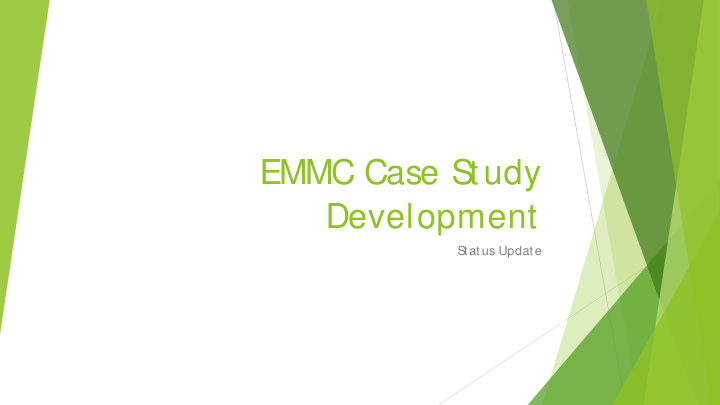



EMMC Case S tudy Development S tatus Update
Obj ectives General consensus regarding the need for case studies on the deployment of materials modelling: Credible case st udies are necessary t o convince end-users of t he performance of t he models. There is an indust rial need for t he development of case st udies and examples of successful applicat ion of modelling and simulat ion t o solve real problems Case studies should illustrate how the integration of different modelling levels (e.g. data modelling, physical modelling, supply chain inputs etc.) have led to a successful decision for industry and should be released and shared as success stories
Progress to date Contact list of all of manufacturers that attended the February 2014 and/ or November 2014 meetings was collated – comprising 21 distinct contacts E-mail to invite cooperation in the development of case studies sent to the contacts on 18 th December 2014, requesting a response by 12 th January 2015. In addition Lula Rosso selected the most promising proj ects that use both discrete and continuum models from chapter 5 of the Modelling Brochure. 23 e-mails sent to the proj ects on 23 rd January 2015, requesting input to be sent back by 30th January 2015.
Outcomes Nine potential case studies identified. Of the 21 contacts in first e-mail shot obtained 5 positive responses. Of the 23 contacts in the second e-mail shot, 3 positive responses were received, highlighting 4 case studies. Most applications are mainly based on continuum models . However, amongst the examples there might be cases that uses discrete modelling to arrive at a new constitutive equations for continuum models: useful for case study. Cases where the constitutive equations are derived from experiments are not considered suitable examples.
Potential case studies Suggested by Topic Modelling type Matthias Funk, Influence of microstructure and fabrication Continuum models based S chaeffler Technologie AG on the strength of steels on existing constitutive equations Filip Oosterlinck, Optimisation of polymer processing through Constitutive equations DS M Ahead B.V . modelling multilayer flow dynamics and for continuum models interface behaviour Thomas Göhler, S imulation of additive manufacturing Continuum MTU Aero Engines AG production of metallic components Pieter Janssen, Optimisation of polymer processing Kinetics and continuum S ABIC Innovative Plastics modelling Arno Plankensteiner, Modelling of Thermo-Mechanical Fatigue Constitutive equations PLANS EE S E (TMF) in metals for continuum models
Potential case studies (continued) Suggested by Topic Modelling type Nenad Filipovic, Development of nanocontainers for self- Mesocopic and Continuum Risk Technologies healing materials Olaf van der S luis, Improvement of interface reliability in Constitutive equations for Phillips microelectronic devices continuum models derived from small scale applications of continuum models Mark Gubbins, Integrated Recording Model for Heat Discrete + Continuum S eagate Assisted Magnetic Recording (HAMR) Mark Gubbins, Integrated Transducer Model for Heat Discrete + Continuum S eagate Assisted Magnetic Recording (HAMR)
Future actions Prioritise and produce a short-list of 3-4 for development . The ‘ selected’ providers of the case studies will be contacted in order to develop the detailed content. This will involve: talking with the providers and collecting the information, drafting the case study and obtaining their comments and permission to use it. Finalise three case studies which can be made ready for the press by the EU communication tender winners. It is estimated that the three case studies will be available by the end of March 2015. Following these three case studies, more could be identified and a request for examples is to be included in the EMMC newsletter to be widely distributed following this meeting.
S uggested template (Part 1) Obj ectives of the industrial customer: Open description of the industrial problem. Classification of the proj ect: Material, Industrial sector, S cale of the material, Industrial application (system, sub-system, component, fluid state, solid state, etc.), Weakness of actual approach (trial and error, only simplified lab experiment, no full scale model, etc.) Requirements and expected results to understand the material behaviour.
S uggested template (Part 2) How materials modelling played a key role in problem solving. Description of the tool(s) and methodology(ies) that have been applied (one scale, multi-scale, optimization strategy, calibration of model before of iterative solution research etc.). Expected improvement of the material behaviour simulation. Technical and technological benefits and return on investment (KPIs and ROI are part of the agreement to measure the modelling outcomes versus industrial investment and previous approach).
Recommend
More recommend